A Bad Day for Saw-Whet Owls
Back in the pines on Whitefish Point, birders attending the festival were clustered happily around a major find. You had to kneel to see it, the pine was so thick with branches.
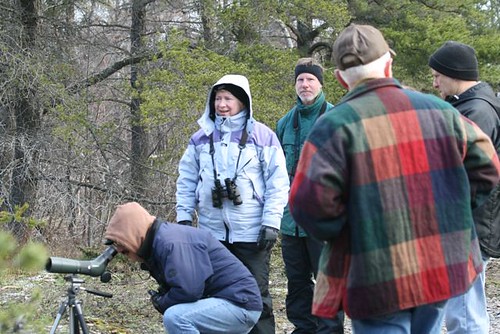
It was a long-eared owl with prey. Close examination through the scope revealed the russet flank streaking of a saw-whet owl in the mess in its talons. Bummer. But that's what big owls do to smaller owls. LEOW's themselves often fall prey to great horned owls. And so it goes.
(September 10, 2008: Nova and Chris from Whitefish Point Bird Observatory have just written to say that examination of the leavings under the LEOW's perch proved that the prey had been a hermit thrush. Thanks, Nova and Chris!)
Nobody much eats GHOW's. Doesn't seem fair somehow. There ought to be a great horned owl-eating owl. Now, that would be a bird. I'm beginning to sound like Jack Handy (Deep Thoughts.)
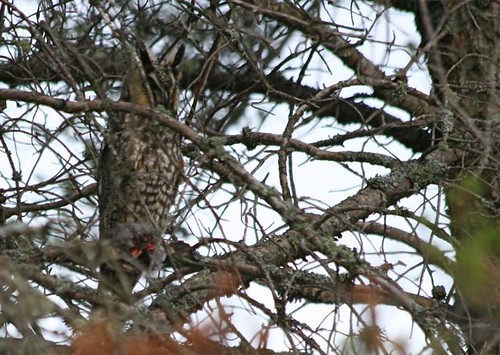
Another saw-whet owl who considered himself fallen on bad fortune, I'm sure, was in the gentle hands of Nova Mackentley, acting co-director, with Chris Nery, of WPBO. Two years ago, they started a summer banding program that illuminated an enormous movement of juvenile saw-whet owls that no one knew about until they started playing tapes next to mist nets. We're learning volumes about these tiny owls thanks to Nova and Chris' efforts, and those of the volunteers who help them. To band saw-whet owls, you have to stay up all night. And consider this: they've caught nearly 1,000 saw-whet owls at Whitefish Point this spring alone!! That's a lot of coffee, a lot of sleepless nights and bleary days.
I am too much of a weenie to band saw-whet owls. This I believe.
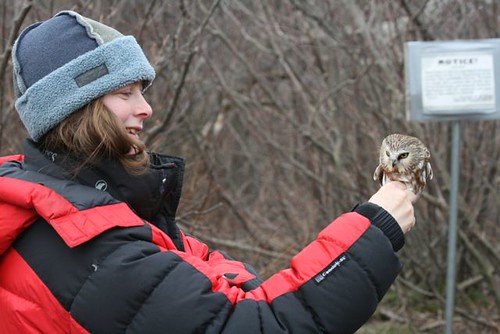
With its wing stretched, the banders could tell its age. This is a second-year bird.
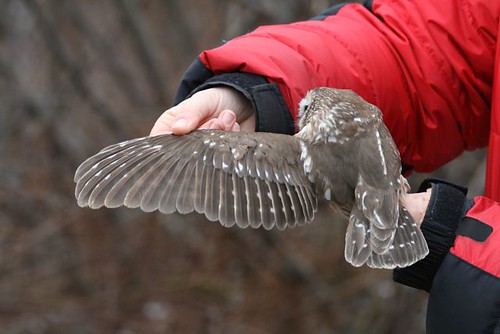
As long as we were annoying the owl, I asked if I might take a peek at its ear.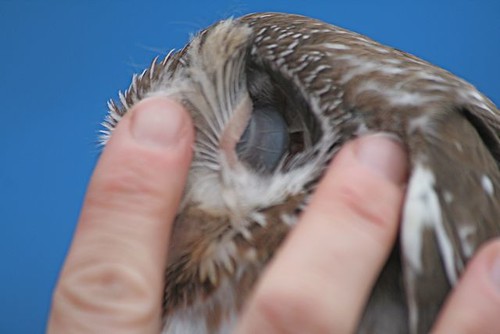
Wanna know what the Science Chimp really, really loves about this picture? That makes her jump up and down, pant-hoot and throw bananas at the ceiling? Well, the bluish bulge inside the ear is actually the back part of the owl's left EYE. Yeah. You're looking at its eye, inside its skull, thinly covered by inner ear skin. Owl eyes are so huge that they are quite vulnerable, so they're protected by bony sclerotic rings, and fixed, immobile, in the skull. This is why owls turn their heads to look at the tiniest thing--because they can't move their enormous eyes from side to side or up and down. And I discovered that you can see an owl's eye by looking in its EAR. Which I didn't figure out until I uploaded the picture and wondered what I was actually seeing. Having skinned a few owls, I realized that I was looking at the bony sclerotic ring. Eee! Eee! Eee! I have to go lie down now.
A heavily ticked-off saw-whet owl. Good thing there isn't a smaller owl in the East. It'd get eaten.
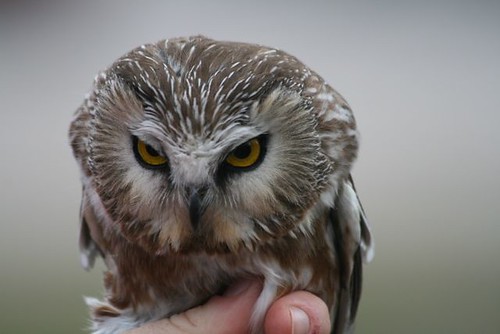
With all thanks to Nova, I prefer my saw-whets on the hoof. And not far from where one had been turned into dinner, and another into an ear model, there was one who was able to rest just a bit before flying north over Superior. Sleep well, little owl. Soon enough you'll be away from all this hubbub.
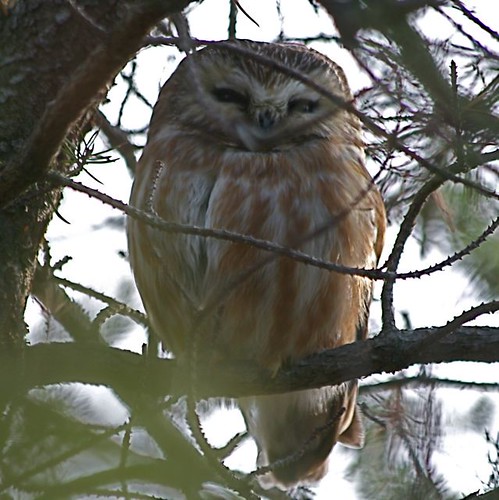
Thanks to everyone who wrote in about Ruby. You're all so nice. It helps.

Another saw-whet owl who considered himself fallen on bad fortune, I'm sure, was in the gentle hands of Nova Mackentley, acting co-director, with Chris Nery, of WPBO. Two years ago, they started a summer banding program that illuminated an enormous movement of juvenile saw-whet owls that no one knew about until they started playing tapes next to mist nets. We're learning volumes about these tiny owls thanks to Nova and Chris' efforts, and those of the volunteers who help them. To band saw-whet owls, you have to stay up all night. And consider this: they've caught nearly 1,000 saw-whet owls at Whitefish Point this spring alone!! That's a lot of coffee, a lot of sleepless nights and bleary days.
I am too much of a weenie to band saw-whet owls. This I believe.

With its wing stretched, the banders could tell its age. This is a second-year bird.

As long as we were annoying the owl, I asked if I might take a peek at its ear.

Wanna know what the Science Chimp really, really loves about this picture? That makes her jump up and down, pant-hoot and throw bananas at the ceiling? Well, the bluish bulge inside the ear is actually the back part of the owl's left EYE. Yeah. You're looking at its eye, inside its skull, thinly covered by inner ear skin. Owl eyes are so huge that they are quite vulnerable, so they're protected by bony sclerotic rings, and fixed, immobile, in the skull. This is why owls turn their heads to look at the tiniest thing--because they can't move their enormous eyes from side to side or up and down. And I discovered that you can see an owl's eye by looking in its EAR. Which I didn't figure out until I uploaded the picture and wondered what I was actually seeing. Having skinned a few owls, I realized that I was looking at the bony sclerotic ring. Eee! Eee! Eee! I have to go lie down now.
A heavily ticked-off saw-whet owl. Good thing there isn't a smaller owl in the East. It'd get eaten.

With all thanks to Nova, I prefer my saw-whets on the hoof. And not far from where one had been turned into dinner, and another into an ear model, there was one who was able to rest just a bit before flying north over Superior. Sleep well, little owl. Soon enough you'll be away from all this hubbub.

Thanks to everyone who wrote in about Ruby. You're all so nice. It helps.
Labels: long-eared owls, Michigan, owl ears, owl eyes, owls eating owls, saw-whet owls, Upper Peninsula, Whitefish Point






<< Home